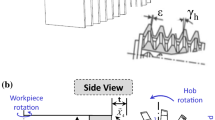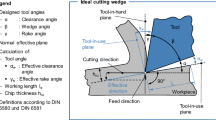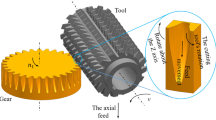Abstract
Typical processes of producing transmission gears involve hobbing, milling, or shaping of a forged stock to obtain the desired gear geometries. Among all these machining processes, gear hobbing is an efficient method of manufacturing high-quality gears. In this paper, a three-dimensional (3D) finite element model is presented to simulate the gear hobbing processes. The model is used to simulate the complicated kinematic motion between the hobbing tools and the gear workpieces and to perform a coupled thermo-mechanical analysis on the tools and the workpieces during the chip removal process. Cutting forces, torques, and temperature and stress distributions of the hobbing tools and workpieces are predicted using the proposed model. The tool wear progression in gear hobbing is analyzed in terms of tool geometry by a combined experimental-analytical method. The model considers the complex geometry of hob tooth profiles with multiple teeth engagement and can provide more insights into complicated gear hobbing processes. Based on the simulations with various tool geometries, a new tool geometry is arrived, which reduces spindle torque and shows a significant tool wear reduction. The modeling results are further validated through a direct comparison between the predicted and measured chip shape, torque, and tool wear rate.
Similar content being viewed by others
References
Davis JR (2005) Gear Materials, Properties, and Manufacture. ASM International, Materials Park, OH, USA
Liu W, Ren D, Usui S, Wadell J, Marusich TD (2013) A gear cutting predictive model using the finite element method. Procedia CIRP 8:51–56
Klocke, F., and Klein, A., 2006, “Tool Life and Productivity Improvement Through Cutting Parameter Setting and Tool Design in Dry High-Speed Bevel Gear Tooth Cutting,” Gear Technol., May/June, pp. 40–48
Rech J (2006) Influence of cutting edge preparation on the wear resistance in high speed Dry gear hobbing. Wear 261:505–512
Rech J, Djouadi MA, Picot J (2001) Wear resistance of coatings in high speed gear hobbing. Wear 250:45–53
Vasilis D, Nectarios V, Aristomenis A (2007) “Advanced computer aided design simulation of gear hobbing by means of three-dimensional kinematics modeling”. ASME J Manuf Sci Eng 129:911–918
Antoniadis A (1988) “Determination of the impact tool stresses during gear hobbing and determination of cutting forces during hobbing of hardened gears”, dissertation. Aristoteles University of Thessaloniki, Thessaloniki, Greece
Sinkevicius V (2001) Simulation of gear hobbing forces. Kaunas University of Technology Journal Mechanika 2:58–63
Antoniadis A, Vidakis N, Bilalis N (2002) “Failure fracture investigation of cemented carbide tools used in gear hobbing—part I: FEM modeling of Fly hobbing and computational interpretation of experimental results”. ASME J Manuf Sci Eng 124:784–791
Antoniadis A, Vidakis N, Bilalis N (2002) “Failure fracture investigation of cemented carbide tools used in gear hobbing—part II: the effect of cutting parameters on the level of tool stresses—a quantitive parametric analysis”. ASME J Manuf Sci Eng 124:792–798
Komori M, Sumi M, Kubo A (2004) “Method of preventing cutting edge failure of Hob due to chip crush”. JSME Int J Ser C 47:1140–1148
Stein S, Lechthaler M, Krassnitzer S, Albrecht K, Schindler A, Arndt M (2012) “Gear hobbing: a contribution to analogy testing and its wear mechanisms,”. Procedia CIRP 1:220–225
Stark S, Beutner M, Lorenz F, Uhlmann S, Karpuschewski B, Halle T (2013) Heat flux and temperature distribution in gear hobbing operations. Procedia CIRP 8:456–461
Third Wave Systems Inc., 2014, Third Wave AdvantEdgeTM 6.2 User’s Manual, Minneapolis, USA.
Marusich TD, Ortiz M (1995) Modelling and simulation of high-speed machining. Int J Num Meth Eng 38:3675–94
Taylor, L. M. and Flanagan, D. P., 1987, “PRONTO 2D: a two-dimensional transient solid dynamics program” Technical Report No. SAND-86-0594, Sandia National Laboratories, Albuquerque, NM, USA
Dimitriou V, Antoniadis A (2009) CAD-based simulation of the hobbing process for the manufacturing of spur and helical gears. Int J Adv Manuf Tech 41:347–357
Bouzakis K-D, Kombogiannis S, Antoniadis A (2002) “Gear hobbing cutting process simulation and tool wear prediction models”. ASME J Manuf Sci Eng 124:42–51
Usui E, Shirakashi T, Kitagawa T (1984) “Analytical prediction of cutting tool wear”. Wear 100:129–151
Zhao H, Barber GC, Zou Q (2002) A study of flank wear in orthogonal cutting with internal cooling. Wear 253:957–962
Yen Y, Söhner J, Lilly B, Altan T (2004) Estimation of tool wear in orthogonal cutting using the finite element analysis. J Mater Process Technol 246:82–91
Lorentzon J, Jarvstrat N (2009) “Modelling the influence of carbides on tool wear”. Archives of Int J Comput Mater Sci Surf Eng 1:29–37
Ding H, Shen N, Shin YC (2012) Thermal and mechanical modeling analysis of laser-assisted micro-milling of difficult-to-machine alloys. J Mater Process Tech 212:601–613
Pálmai Z (2013) Proposal for a new theoretical model of the cutting Tool’s flank wear. Wear 303:437–445
Hindustan Machine Tools Limited, 2001, “Production Technology”, Tata McGraw-Hill Education, New York, NY, USA, pp. 325–335.
Bianco Gianfranco, 29 December 2014, Dry Hobbing—more information (2), http://www.biancogianfranco.com/Agg%20Area%20UK/Hobs/Dry%20hobbing%20-%20more%20information%20(2).pdf
Spittel, M., and Spittel, T., 2009, “Steel Symbol/Number: 34Cr4/1.7033,” Metal Forming Data of Ferrous Alloys - Deformation Behaviour, Landolt-Börnstein - Group VIII Advanced Materials and Technologies, Springer Berlin Heidelberg, pp. 996–1001.
Matbase, 29 December 2014, 34Cr4 (High grade steel), http://www.matbase.com, /material-categories/metals/ferrous-metals/high-grade-steel/material-properties-of-high-grade-steel-34cr4.html#properties
Metal Ravne, 29 December 2014, Steel VC130 (Mat.No. 1.7033, DIN 34Cr4, AISI 5132), http://www.metalravne.com/selector/steels/vc130.html
eFunda, Inc., 29 December 2014, eFunda: properties of alloy steel AISI 5132, http://www.efunda.com/materials/alloys/alloy_steels/show_alloy.cfm?ID=AISI_5132&show_prop=all&Page_Title=AISI%205132
Author information
Authors and Affiliations
Corresponding author
Rights and permissions
About this article
Cite this article
Dong, X., Liao, C., Shin, Y. et al. Machinability improvement of gear hobbing via process simulation and tool wear predictions. Int J Adv Manuf Technol 86, 2771–2779 (2016). https://doi.org/10.1007/s00170-016-8400-3
Received:
Accepted:
Published:
Issue Date:
DOI: https://doi.org/10.1007/s00170-016-8400-3




